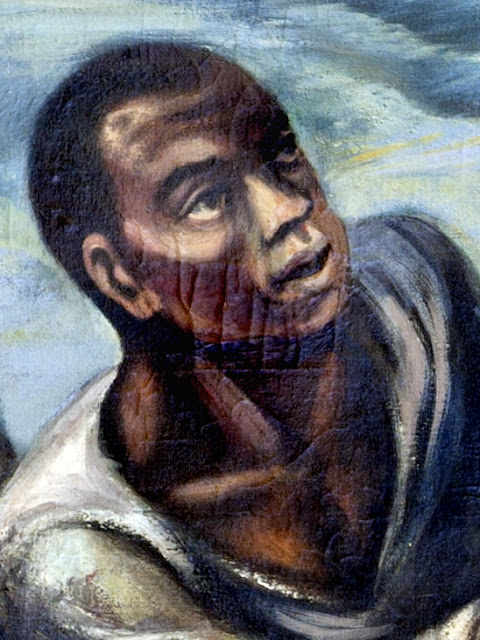The USS Lawrence sustained irreparable damage and—with over 80% of her crew injured from British cannon—began to sink. Perry abandoned his flagship, transferring his flag and command to the USS Niagara, the only other brig in the flotilla. He chose four trusted sailors to row across the half-mile distance to the Niagara from his damaged flagship. One of the sailors was Cyrus Tiffany who used his body to protect Perry from the heavy, sustained gunfire and musketry of nearby British vessels. Once on the USS Niagara Perry rallied his men and defeated the British naval forces. In doing so he became a hero of the War of 1812. This battle was the first time in history that an entire British naval squadron had surrendered. -- Blackpast.
The Lawrence had been named for Captain James Lawrence whose dying words were famously “Don't Give Up the Ship!” Perry's battle flag on the Lawrence famously read “Don't Give Up the Ship!” and here he is depicted heroically giving up the ship.
This exploit, protecting Perry as he rowed away from the Lawrence, is sparsely documented, as is much of the life of Cyrus Tiffany. “Old Tiffany” was a septuagenarian at the time of the battle of Lake Erie. Gene Allen Smith in his 2013 book The Slaves Gamble, says this of Cyrus Tiffany.
Cyrus Tiffany was one of the most noticeable African American seamen in Perry's crew. "Old Tiffany," as he was affectionately called, was Perry's personal servant as well as an excellent fifer, an instrument that he had reportedly played for George Washington. On the day of the battle Perry armed Tiffany, placed him on the berth deck of the Lawrence, and instructed him to force up to the main deck everyone skirting their duty. Perry knew that this assignment would keep his favorite servant out of harm's way and most likely save his life. Even so, during the heat of battle the overzealous Tiffany allowed the berth deck hatchway to become crowded with the wounded he would not permit below, condemning them as skulkers. Tiffany, one of the few aboard the Lawrence who did not die or suffer injury during the engagement, remained at his commodore's side until Perry's death in 1819. -- Gene Allen Smith.
This fife believed to have belonged to Cyrus Tiffany now belongs to the Erie Maritime Museum.
In the famous painting of Perry's Victory by William H. Powell which hangs in the U.S. Capitol, the role played by Tiffany in Schweig's painting is played by a white person.
from The War of 1812 by Richardson and Casselman, 1902
Gene Allen Smith's comment on Powell's painting points out another African American in Perry's crew. “Among the sailors rowing Oliver Hazard Perry's boat was Hannibal Collins, a black man depicted in the background with his arm raised near the bow.” It is estimated that about 10% of the crew of the Lawrence were African American.
Perry's statue in Cleveland shows the same scene.Statue erected in Olive Park, in honor of Commodore Oliver Hazard Perry the Hero of Lake Erie.-- Designed by William Walcutt and inaugurated at Cleveland, Ohio, September 10, 1860. -- Frank Leslie's Illustrated Newspaper Vol. X, No. 251, September 15, 1860.








No comments:
Post a Comment